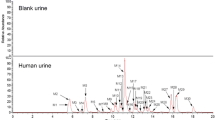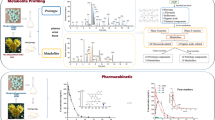Abstract
NaoMaiTong (NMT), consisting of Radix et Rhizoma Rhei, Radix Ginseng, Radix Puerariae, and Rhizoma Ligustici Chuanxiong, is widely used for treating ischemia cerebral apoplexy. In this work, a rapid high-performance liquid chromatograph coupled with a quadrupole-orbitrap mass spectrometer (HPLC-Q-Orbitrap) was developed for detection and identification of chemical compounds in rat urine after oral administration of NaoMaiTong and its single herbs. Using targeted screening and the mass defect filter of MetWorks™ software, a total of 157 ingredients were detected in the NaoMaiTong drug-containing group within 36 h, including 70 prototype chemicals and 61 related metabolites that were unambiguously discriminated. There were anthraquinones, triterpenoid saponins, isoflavones, puerosides, phthalides, phenolic acid, etc. Twelve triterpenoid saponins, including 7 metabolites, were first discovered in rat urine after administration. Mirificin-Glc and methoxypuerarin were first discovered in the Radix Puerariae. The results indicated that glucuronidation and sulfation were the main metabolic pathways of Radix et Rhizoma Rhei and Radix Puerariae. In addition to glucuronidation and sulfation, other conjugation reactions also occurred in the metabolisms of Rhizoma Ligustici Chuanxiong such as cysteine conjugation and acetylcysteine conjugation, while phase I reactions (e.g., deglycosylated, hydroxylated) were the major metabolic reaction for Radix Ginseng. Many compounds from its single herb-dosed groups presented different absorption trends and slower elimination rates in the urine from the NMT-dosed group compared with the urine from the single-dosed groups. These results will provide helpful information for further basic research into the active substances in NaoMaiTong.
Graphical abstract





Similar content being viewed by others
References
Ren XQ, Li JS, Feng YM, Lu YQ (2004) Neuro-protective effect of NaoMaiTong to brain damage after focal cerebral ischemia reperfusion(I R)in the aged rats. China J Chin Mater Med 29:66–70 (in Chinese)
Li JS, Guo DM (2005) Clinical effect analysis of acute cerebral infarction treated by Naomaitong granules. China J Tradit Chin Med Pharm 20:563–565 (in Chinese)
Li JS, Gao JF, Zhou YL, Liu K (2006) Neuro-protective effect of Naomaitong to inflammatory cascade response after focal cerebral ischemia reperfusion in aged rats. China J Chin Mater Med 31:1804–1807 (in Chinese)
Liu K, Li JS, Gao JF, Yang XK, Zhou YL, Zhao YW, Liu ZG, Liu JX (2010) Effect of Naomaitong on cerebral angiogenesis and expressions of VEGF and VEGFR after cerebral ischemia/reperfusion in aged rats. China J Tradit Chin Med Pharm 12:2088–2092 (in Chinese)
Chen X, Yang YX, Wang SM, Wang ZH, Su ZB, Li JS, Liang SW (2012) Study on effects of extract in Naomaitong formula on cerebral ischemia–reperfusion model based on NMR metabolomics. Chin Tradit Herb Drugs 43:97–102 (in Chinese)
Wang SM, Li SF, Liang SW, Gao SJ, Li JS (2009) Separation and purification of Naomaitong granules by AB-8 macroporous absorption resin. Chin Tradit Patent Med 31:47–50 (in Chinese)
Rong YY, Feng SX, Wu CW, Wang SM, Liang SW, Liu DY (2016) LC-high-resolution-MS/MS analysis of chemical compounds in rat plasma after oral administration of Nao-Mai-Tong and its individual herbs. Biomed Chromatogr 13:1–13
Wu CW, Zhao L, Rong YY, Zhu GX, Liang SW, Wang SM (2016) The pharmacokinetic screening of multiple components of the NaoMai Tong formula in rat plasma by liquid chromatography tandem/mass spectrometry combined with pattern recognition method andits application to comparative pharmacokinetics. Pharm Biomed Anal 131:345–354
Zhang H, Zhang D, Ray K (2003) A software filter to remove interference ions from drug metabolites in accurate mass liquid chromatography/mass spectrometric analyses. Mass Spectrom 38:1110–1112
Song R, Xu L, Xu FG et al (2010) In vivo metabolism study of rhubarb decoction in rat using high-performance liquid chromatography with UV photodiode-array and mass-spectrometric detection: a strategy for systematic analysis of metabolites from traditional Chinese medicines in biological samples. Chromagr A 127:7144–7152
Wang M, Fu JF, Lv MY et al (2014) Effect of wine processing and acute blood stasis on the serum pharmacochemistry of rhubarb: a possible explanation for processing mechanism. Sep Sci 27:2499–2503
Jiang P, Liu RH, Dou SS et al (2009) Analysis of the constituents in rat plasma after oral administration of Shexiang Baoxin pill by HPLC-ESI-MS/MS. Biomed Chromatogr 23:1333–1343
Qian TX, Jiang ZH, Cai ZW (2006) High-performance liquid chromatography coupled with tandem mass spectrometry applied for metabolic study of ginsenoside Rb1 on rat. Anal Biochem 352:87–96
Kim U, Park MH, Kim DH et al (2013) Metabolite profiling of ginsenoside Re in rat urine and faeces after oral administration. Food Chem 136:1364–1369
Xu Q, Tan YJ, Su XJ, Luo WS (2009) Stuides on chemical constituents of Rheum palmatum. Chin Tradit Herb Drugs 40(4):536
Song R, Xu L, Xu FG, Li ZG, Dong H, Tian Y, Zhang Z (2010) In vivo metabolism study of rhubarb decoction in rat using high-performance liquid chromatography with UV photodiode-array and mass-spectrometric detection: a strategy for systematic analysis of metabolites from traditional Chinese medicines in biological samples. Chromagr A 127:7144–7152
Wu WJ, Hu N, Zhang QW, Li YP, Li P, Yan R, Wang YT (2014) In vitro glucuronidation of five rhubarb anthraquinones by intestinal and liver microsomes from humans and rats. Chem Biol Interact 219:18–27
Wu WJ, Yan R, Yao MC, Zhan Y, Wang YT (2014) Pharmacokinetics of anthraquinones in rat plasma after oral administration of a rhubarb extract. Biomed Chromatogr 28:564–572
Song R, Xu FG, Zhang ZJ, Liu Y, Dong HJ, Tian Y (2008) Structural elucidation of in vitro metabolites of emodin by liquid chromatography–tandem massspectrometry. Biomed Chromatogr 22:1230–1236
Koyama J, Takeuchi A, Morita I, Nishino Y, Shimizu M, Inoue M, Kobayashi N (2009) Characterization of emodin metabolites in Raji cells by LC–APCI-MS/MS. Med Chem 17:7493–7499
Qiu S, Yang WZ et al (2015) A green protocol for efficient discovery of novel natural compounds: characterization of new ginsenosides from the stems and leaves of Panax ginseng as a case study. Anal Chim Acta 893:65–76
Qi LW, Wang HY, Zhang H, Wang CZ, Li P, Yuan CS (2012) Diagnostic ion filtering to characterize ginseng saponins by rapid liquid chromatography with time-of-flight mass spectro- metry. Chromatogr A 1230:93–99
Wan JW, Wang CZ et al (2016) Determination of American ginseng saponins and their metabolites in human plasma, urine and feces samples by liquid chromatography coupled with quadrupole time-of-flight mass spectrometry. Chromatogr B 1015:62–73
He CY, Zhou DD, Li J, Han H, Ji G, Yang L, Wang Z (2014) Identification of 20(S)-protopanaxatriol metabolites in rats by ultra-performance liquid chromatography coupled with electro- spray ionization quadrupole time-of-flight tandem mass spectrometry and nuclear magnetic resonance spectroscopy. Pharm Biomed Anal 88:497–500
Zhou SS, Xu JD et al (2014) Simultaneous determination of original, degraded ginsenosides and aglycones by ultra high performance liquid chromate- graphy coupled with quadrupole time-of-flight mass spectrometry for quantitative evaluation of Du-Shen-Tang, the decoction of ginseng. Molecules 19:4083–4104
Yang HY, Lee DY, Kyobin K, Kim JY, Kim SO, YooYH Sung SH (2015) Identification of ginsenoside markers from dry purified extract of Panax ginseng by a dereplication approach and UPLC–QTOF/MS analysis. Pharm Biomed Anal 109:91–104
Wu W, Qin QJ, Guo YY, Sun JH, Liu SY (2012) Studies on the chemical transformation of 20(S)-protopanaxatriol (PPT)-type ginsenosides R(e), R(g2), and R(f) using rapid resolution liquid chromatography coupled with quadruple-time-of-flight mass spectrometry (RRLC-Q-TOF-MS). Agric Food Chem 60(40):10007–10014
Xing QQ, Liang T, Shen GB, Wang XL, Jin Y, Liang XM (2012) Comprehensive HILIC × RPLC with mass spectrometry detection for the analysis of saponins in Panax notoginseng. Analyst 137(9):2239–2249
Miao WJ, Wang Q, Bo T et al (2013) Rapid characterization of chemical constituents and rats metabolites of the traditional Chinese patent medicine Gegen–Qinlian–Wan by UHPLC/DAD/qTOF-MS. Pharm Biomed Anal 72:99–108
Yan Y, Chai CZ et al (2013) HPLC-DAD-Q-TOF-MS/MS analysis and HPLC quantitation of chemical constituents in traditional Chinese medicinal formula Ge-Gen Decoction. Pharm Biomed Anal 80:192–202
Levsen K, Schiebel HM, Behnke B et al (2005) Structure elucidation of phase II metabolites by tandem mass spectrometry: an overview. Chromatogr A 1067:55–72
Yan R, Ko NL, Li SL, Tam YK, Lin G (2008) Pharmacokinetics and metabolism of ligustilide, a major bioactive component in Rhizoma Chuanxiong, in the rat. Drug Metab Dispos 36:400–408
Zhang N, Zhang X, Liu X, Wang H, Xue J, Yu J et al (2014) Chrysophanol inhibits NALP3 inflammasome activation and ameliorates cerebral ischemia/reperfusion in mice. Mediat Inflamm. doi:10.1155/2014/370530
Ahn SM, Kim HN, Kim Y et al (2017) Emodin from Polygonum multiflorum ameliorates oxidative toxicity in HT22 cells and deficits in photothrombotic ischemia. J Ethnophamacol 188:13–20
Liu XY, Zhou XY, Hou JC, Zhu H et al (2015) Ginsenoside Rd promotes neurogenesis in rat brain after transient focal cerebral ischemia via activation of PI3 K/Akt pathway. Acta Pharmacol Sin 36:421–428
Zhou XM, Cao YL, Dou DQ (2006) Protective effect of ginsenoside-Re against cerebral ischemia/reperfusion damage in rats. Biol Pharm Bull 29:2502–2505
Chen W, Guo Y, Yang W, Zheng J, Tong W (2015) Protective effect of ginsenoside Rb1 on integrity of blood–brain barrier following cerebral ischemia. Exp Brain Res 233:2823–2831
Aras AB, Guven M, Akman T, Ozkan A et al (2015) Neuroprotective effects of daidzein on focal cerebral ischemia injury in rats. Neural Regen Res 10:146–152
Hu Y, Duan M, Liang S, Wang Y, Feng Y (2015) Senkyunolide I protects rat brain against focal cerebral ischemia–reperfusion injury by up-regulating p-Erk1/2, Nrf2/HO-1 and inhibiting caspase 3. Brain Res 1605:39–48
Peng B, Zhao P, Lu YP, Chen MM, Sun H, Wu XM, Zhou L (2013) Z-ligustilide activates the Nrf2/HO-1 pathway and protects against cerebral ischemia–reperfusion injury in vivo and in vitro. Brain Res 1520:168–177
Cheng CY, Su SY, Tang NY, Ho TY, Lo WY, Hsieh CL (2010) Ferulic acid inhibits nitric oxide-induced apoptosis by enhancing GABA(B1) receptor expression in transient focal cerebral ischemia in rats. Acta Pharmacol Sin 31:889–899
Author information
Authors and Affiliations
Corresponding author
Ethics declarations
Conflict of interest
The authors declare that they have no conflict of interest.
Ethical approval
All applicable international, national, and institutional guidelines for the care and use of animals were followed.
Funding
This study was funded by 81274060 and 81473413.
Electronic supplementary material
Below is the link to the electronic supplementary material.
Rights and permissions
About this article
Cite this article
Fan, X., Rong, Y. & Wang, S. Analysis of NaoMaiTong Metabolites Using High-Performance Liquid Chromatography/High-Resolution Mass Spectrometry in Rat Urine. Chromatographia 80, 1371–1399 (2017). https://doi.org/10.1007/s10337-017-3363-6
Received:
Revised:
Accepted:
Published:
Issue Date:
DOI: https://doi.org/10.1007/s10337-017-3363-6




